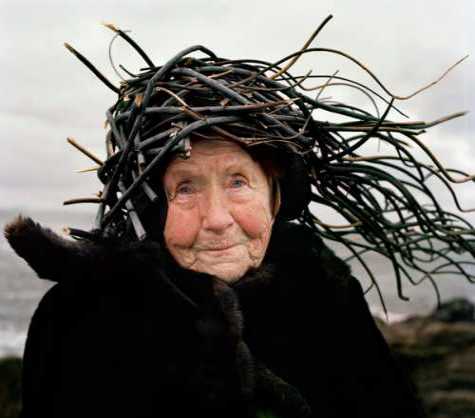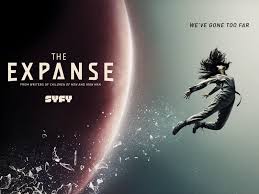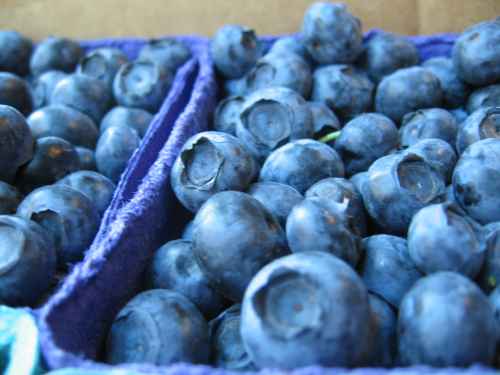Something Old, Something New, Something Borrowed, Something Blue

Something/Someone Old

Today's Something Old is someone I'm going to miss:
This music is associated in my mind forever with moving to Gainesville when I was twelve. I count myself lucky to have seen the Heartbreakers in 1981 on their Hard Promises tour, which this song is from. It was one of the best concerts I've ever attended.
The thing I admire about Tom Petty is his absolute fucking unwillingness to give up. That, and his unpretentious honesty.
And, of course, his talent:
I didn't cry all afternoon, like I did when Bowie died, but my life has lost something because Tom Petty and his music are gone.
Something New
![]()
Lately I'm watching a science fiction series called The Expanse. It debuted in 2015, but as you've no doubt noticed, "new" is relative for me, and can go back as far as 2014.

Anything that crosses detective fiction or film noir with science fiction is usually good by me (I adore Blade Runner, for instance). And that's what The Expanse does, or at least what it starts with: three different people all working different ends of the same mystery, the same conspiracy. Whoever wrote it loves film noir, because it begins classically, with a missing woman case being brought to a hardboiled detective--a case that will change his life:
I almost passed up watching this series because it had a torture scene, and these days, I have a very low tolerance for that. Since 9/11, such scenes are often fetishized or used for the purposes of those who support the normalization of torture (Battlestar Galactica and The 4400 remain glorious exceptions, but such exceptions have become fewer and fewer as time goes on). I switched the show off and almost didn't go back to it. But I decided to give it a chance, and boy, am I glad I did. (There's only one torture scene, and it's not gratuitous nor does it exist for the purposes of excusing torture.)
I honestly don't know how this show keeps from being cancelled, given the issues it's bringing up: colonization, torture, police states, grinding poverty, extreme wealth, and what happens to people who challenge these things. Often, these days, TV shows use the imperfections of those fighting against injustice as a way of promoting a sloppy kind of ethics that states that because people are imperfect, there is no good or evil and anyone opposing injustice is a child, a fool, or a fanatic. (This same philosophy exists in politics; if you've ever been called a naive purist by a partisan Democrat or a neoliberal, you've met this philosophy with its business suit on.) However, The Expanse does not use the imperfections of its heroes as a way of letting gross injustice off the hook. Horrors are still horrors, and horrors done on purpose are unjustifiable atrocities.
And for those who like their science fiction well thought out, the technology and science of this show feel solid as rock to me.
I absolutely recommend it, with one caveat: while the story is not altogether grim, neither is it cheerful. Horrible things happen. So if you're in a state of mind where you can't handle watching something fairly dark, then you should eschew it. Otherwise, as Tom Petty might say, damn the torpedoes. Watch it fast, watch it now.
Something Borrowed

I'm still on a "borrowed words" kick.
Did you know that we got the word "bankrupt" from the Italians?
The word “bankrupt” comes from Italian banca rotta, which (translated) means “broken bench.” In Italy, money dealers worked from tables, or benches. When a money dealer ran out of money, his table (or bench) would be broken, and he could no longer deal money. Hence, the development of the use of the word banca rotta. The word had its French equivalent, banqueroute, and then made its way into the English language in the mid 1500s. The term was used both as a figure of speech, as well as a literal definition to describe what happened to a few unfortunate folks.
https://www.wyzant.com/resources/lessons/english/etymology/words-mod-ban...
That's funny, because I always thought bankruptcy was like a bank rupturing. "There's a rupture in my bank, and all the money's flowing out!" That kind of thing.
But I bet this is also where the slang "broke" came from.
Something Blue

I missed the picking season this year, but I freaking love these things:

Used to be, one of my favorite things to do, in season, was to get up very early in the morning, go picking, be done by 10:30 or 11 (very important in Florida in late May or June), and then go to the springs and go swimming. Luckily, they grow all over the place, so when I lived in Maryland, I went picking there too!
This is what Wikipedia has to say about them. Apparently they are native to this continent, and are related to cranberries:
Blueberries (Vaccinium corymbosum) are perennial flowering plants with indigo-colored berries. They are classified in the section Cyanococcus within the genus Vaccinium. Vaccinium also includes cranberries, bilberries and grouseberries.[1] Commercial "blueberries" are native to North America, and the "highbush" varieties were not introduced into Europe until the 1930s.[2]
The original native was a lowbush blueberry. The ones that are cultivated and sold in supermarkets (and at U-pick farms) are highbush berries.
The Blueberry Council apparently knows who originally cultivated the highbush blueberry in the early twentieth century. Their names were Dr. Frederick Coville and Elizabeth White.
This is Dr. Coville:
Frederick Vernon Coville (March 23, 1867 – January 9, 1937) was an American botanist who participated in the Death Valley Expedition (1890-1891), was honorary curator of the United States National Herbarium (1893-1937), worked at then was Chief botanist of the United States Department of Agriculture (USDA), and was the first director of the United States National Arboretum. He made contribution to economic botany and helped shape American scientific policy of the time on plant and exploration research.
His greatest work was apparently an expedition to Death Valley and a cataloguing of its flora, particularly medicinal plants of the desert.
Coville participated in the 1891 Death Valley Expedition led by C. Hart Merriam and T. S. Palmer, his resulting Botany of the Death Valley Expedition (1893) is an important work on desert plants. He traveled a lot in the Western United States and grew an interest for desert and medicinal plants, leading to his 1897-1898 Medicinal Plants Survey. Gifford Pinchot called a report of Coville's on effects of grazing on forest "the essentials of a sound and farsighted grazing policy". Coville also participated in and wrote on the 1899 Harriman Alaska Expedition, although he never completed his Flora of Alaska. He was involved with the establishment of the Carnegie Institution's Desert Botanical Laboratory in 1903, the USDA Seed Laboratory, and spearheaded efforts that lead to the foundation of the United States National Arboretum in 1927.
https://en.wikipedia.org/wiki/Frederick_Vernon_Coville
That sounds like a substantial and beneficial life's work. But I have to admit, I was more interested in the fact that a woman was involved in this work in the early twentieth century. Who was Elizabeth White? I looked up her story:
Elizabeth Coleman White, born 1871, was the oldest of the four daughters of Joseph J. And Mary A. (Fenwick) White of New Lisbon, NJ. At the age of 22 Elizabeth began working on her family's cranberry plantation at Whitesbog in the heart of the New Jersey Pine Barrens. Unlike her sisters, Elizabeth never married but spent the balance of her 83 years involved in many pursuits at Whitesbog and throughout the Pines region. One of these endeavors, the first successful attempt to cultivate blueberries, earned her a national reputation as a horticulturist and significantly modified the economy of the New Jersey Pine Barrens and other similar areas throughout the country.
Her first job at the bogs in 1893 was handing out tickets to the harvest crew in return for the boxes of cranberries that they picked by hand during the fall months. During the next 18 years, Elizabeth exhibited interest in finding ways to continue the improvement of the business at Whitesbog which was rapidly expanding into the largest cranberry operation in the state. During the first decade of the twentieth century, she collaborated with Dr. John B. Smith, a government entomologist, who studied and eliminated a type of katydid that was ruining the crops. Then, in 1911, Elizabeth read the U.S.D.A. publication entitled, "Experiments in Blueberry Culture," researched and written by Dr. Frederick V. Coville (Coville 1910). Realizing the potential value of the work, Elizabeth contacted Coville to offer him support in his work. (Hambidge 1927).
http://fredcoville.blogspot.com/2012/05/elizabeth-coleman-white_16.html
She employed locals, natives of the Pine Barrens who were essentially woodsmen, hunter-gatherers, to find the best blueberry bushes for her out in the swamps. Coolest of all, when they brought back blueberry strains she could use, she named the strains after the men who found them:
In 1916, only five years after Elizabeth White's alliance with Dr. Coville, they had managed to cultivate and produce a blueberry crop for sale. Contributing to the effort were three parties: Coville, who offered the scientific knowledge and technique necessary to propagate and hybridize fruit; J.J. White, Inc., and particularly Elizabeth C. White, who offered financing and the Whitesbog infrastructure necessary to carry out experiments on a large scale; and, finally, the "Pineys" themselves. It was the contribution of the latter which is perhaps the most interesting. The Pineys were enlisted by Miss White to employ their woodsmen's skills as hunter-gatherers to search the Pines within a 20-mile radius of Whitesbog and locate the choicest blueberry shrubs. Elizabeth recalled the ability of these men in distinguishing the endless varieties of blueberry:
"... As I was hunting wild blueberry bushes I learned that the old blueberry pickers that were going to the different swamps recognized a difference in the class of bushes in each swamp. For instance, in Iricks Swamp I was told that the majority of the berries were pear shaped and I was told that in Feather Bed Swamp the majority of the berries were very blue and flattened. (White 1953: personal communication)."
Elizabeth devised a plan to tap this knowledge in order to locate the best possible plants in the area, in effect, to locate the one bush out of 10,000 having exceptionally fine characteristics for propagation. Pickers going into the woods for the wild berries were organized under either Jake Sooy or Alfred Stevenson and equipped with labels, bottles containing the preservative formalin, and an aluminum gauge with a 5/8-inch diameter hole. Only bushes having berries 5/8 inch or larger were sought. The effort was rewarded at $2.00 per bush plus the time required for relocating each plant and bringing it back (Hambidge 1927). In addition, the finders enjoyed the distinction of having the bushes which they found named after them. Thus it was that the last generation of the highly skilled woodsmen-gatherers gave their names to the first cultivated blueberries, as Miss White recalls:
"In getting the early bushes I tried to name every bush after the finder. And so I had the Adams bush found by Jim Adams, the Harding bush that was found by Ralph Harding, and the Dunphy bush that was found by Theodore Dunphy. When Sam Lemon found a bush I could not name it the Lemon bush so I called it the Sam. Finally, Rube Leek of Chatsworth found a bush. I did not know it was anything special at that time and I used the full name in my notes.... Coville called it the Rube which I thought was a poor name for an aristocratic bush. He finally suggested that we call it the Rubel. And the Rubel bush has really been the keystone of blueberry breeding. It is the one bush of which there are hundreds of acres planted just by divisions. It's still in cultivation [1953] and I still consider it a good bush. It also enters into the inheritance in two or three directions of all the accepted varieties of the present day." (White 1953: personal communication)
I really like the respect for the workers and their knowledge that she shows in naming the strains after them. You can hear it in her words.
Anyway, I love blueberries. Here's to Coville, White, and the Pineys to whom we owe the modern plant.


Comments
Yum ... blueberries
In our part of the world (the SE) it is the rabbiteye blueberry that is most common...
They began a breeding program in Georgia in the 1900's...
http://www.georgiablueberries.org/general-info/history
Here's some general recommendation about varieties , care, and plantings.
http://extension.uga.edu/publications/detail.html?number=C946&title=Home...
We have 30 year old bushes that still produce fruit. One big advantage is the deer don't bother them. We do cover some bushes with bird netting because the turkeys love them. I've seen several young turkeys up in a bush at one time with mama working it from the ground (we always leave them access to some plants...it's important to share the wealth at many levels).
Another nice aspect of this fruit is easy preservation. After picking (don't wash them), place in a single layer on a metal pan and put them in the freezer for about an hour until frozen. Pour the frozen berries into a milk jug and put on the lid placing it back in the freezer. When you're ready for blueberries during the year pour out what you plan to use, rinse them off (which largely thaws them), and use like you would fresh picked. Put the remainder back in the freezer.
Great fruit and crop in our part of the world!
Hope you all have a berry nice day!
“Until justice rolls down like water and righteousness like a mighty stream.”
Hey guys
Boy, did I have a rough night last night. I'm still well (hooray!) but I had the most awful nightmare I kept falling back into. Finally, I just stayed up at 4 in the morning playing computer games. I got very little sleep, so I'm not at my best! But good morning to you all nonetheless!
"More for Gore or the son of a drug lord--None of the above, fuck it, cut the cord."
--Zack de la Rocha
"I tell you I'll have nothing to do with the place...The roof of that hall is made of bones."
-- Fiver
Sorry about that, CSTMS!
Sorry about that, CSTMS!
Glad you're with us now, even so!
"US govt/military = bad. Russian govt/military = bad. Any politician wanting power = bad. Anyone wielding power = bad." --Shahryar
"All power corrupts absolutely!" -- thanatokephaloides
Wonderful read and comments too
I enjoyed your essay very much and Lookout's embellishment. Thank you!
Marilyn
"Make dirt, not war." eyo
@mhagle Thanks, Marilyn!
Thanks, Marilyn!
Gotta love them blueberries.
"More for Gore or the son of a drug lord--None of the above, fuck it, cut the cord."
--Zack de la Rocha
"I tell you I'll have nothing to do with the place...The roof of that hall is made of bones."
-- Fiver
That's bold
@gjohnsit Never is a long time.
Never is a long time.
"More for Gore or the son of a drug lord--None of the above, fuck it, cut the cord."
--Zack de la Rocha
"I tell you I'll have nothing to do with the place...The roof of that hall is made of bones."
-- Fiver
Blueberries
the best. Around here, New England, we go for the wild ones. My wifes family have been making muffins in a so-called Gem pan ( 12 slots, 2x6, sort of 1/2 cylinders) forever. Around the time the first commercial crops were coming in, the baking companies went nuts with recipes. I have had some luck transplanting the high bush, but the lows get severe transplant shock. The high bush are different. One's more blue with a kind of powdery finish the other's are deep is purple and shiny. Will check out the others as I find them. Some of the older ones I've seen top out at around 10' and stems as thick as your wrist. Thanks to you and Lookout for the diversion.
@Snode Sure thing!
Sure thing!
"More for Gore or the son of a drug lord--None of the above, fuck it, cut the cord."
--Zack de la Rocha
"I tell you I'll have nothing to do with the place...The roof of that hall is made of bones."
-- Fiver
Several area with blueberries protected near here
(in NY called land use areas) Highbush, mostly. There are always blueberries in my freezer. But I have a cranberry I need to put somewhere on my property. And a quince. Decisions.
Hey! my dear friends or soon-to-be's, JtC could use the donations to keep this site functioning for those of us who can still see the life preserver or flotsam in the water.
@riverlover Yum!
Yum!
"More for Gore or the son of a drug lord--None of the above, fuck it, cut the cord."
--Zack de la Rocha
"I tell you I'll have nothing to do with the place...The roof of that hall is made of bones."
-- Fiver
I have recently tried watching bladrunner twice, but I still
have no idea what it was about. I love a good sci-fi series, stargate sg1 is my favorite as well as Star Trek tng.
I watched continuum, darkmatter and a few other ones. Oh yeah, agents of shield. I'm watching fringe now and I'm on season 5. Not great, but not bad either.
The expanse has been recommended too.
I also enjoy reading fantasy/sci-fi books. Even though Fablehaven is supposed to be a kid's book, this series is much like Harry Potter. It starts out light reading, but then gets darker.
Scientists are concerned that conspiracy theories may die out if they keep coming true at the current alarming rate.